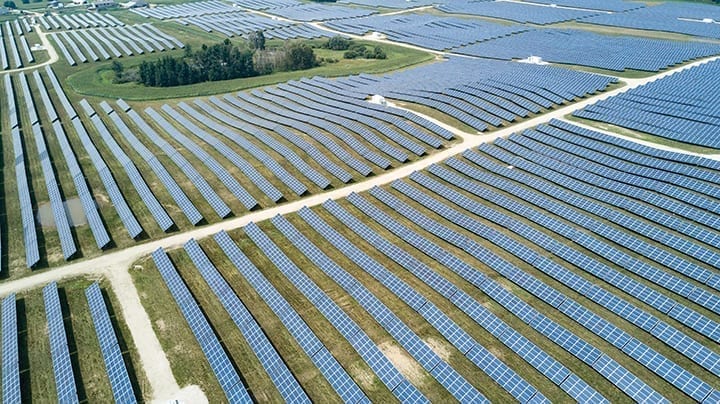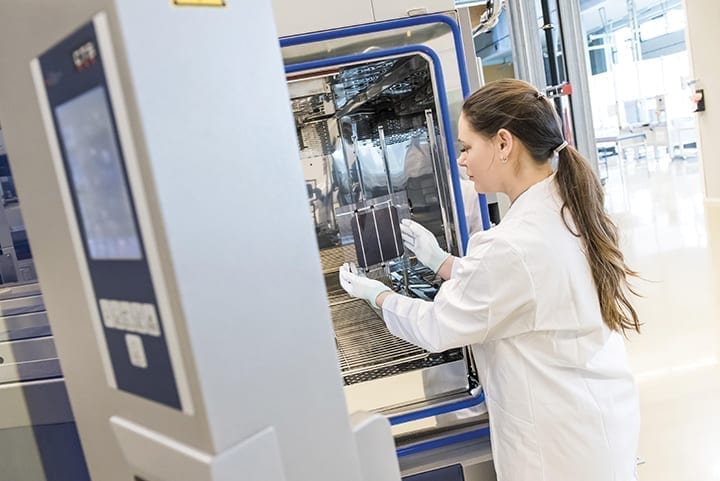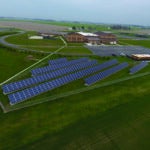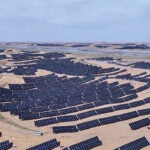Researchers continue to work on improvements in solar power, developing better cells, using new materials in panels, and focusing on improving efficiency while lowering cost.
The solar power industry hit headwinds in 2020. The coronavirus pandemic disrupted supply chains and reduced the workforce; tariffs increased the cost of equipment; and tax credits began to wind down.
But industry insiders continue to predict renewable energy will drive the economic recovery from COVID-19, and solar power is expected to play a lead role as local governments set renewable energy targets, countries and states establish decarbonization goals, and more utilities phase out the use of fossil fuels for power generation.
While growth in the solar sector has slowed from its pre-pandemic pace, research and development of advanced solar power technologies has remained strong. From larger, more powerful, and more efficient solar panels, including upgrades to bifacial technology; to building-integrated photovoltaics (BIPV); to floating solar farms—what some call “floatovoltaics”; to concepts such as solar skins, solar fabric, and even solar roads, there’s no shortage of ideas and new products.
 |
|
1. Tracking technology for solar power continues to evolve. Axsus has deployed its fixed-tilt tracker at several projects, including this 60-MW installation in Mount Forest, Ontario, Canada. Courtesy: Axsus |
“As we enter 2021, all industries will continue to grapple with uncertainties related to COVID-19, but the solar industry is uniquely positioned to thrive while maintaining safe work environments,” said Robert Souliere, director, Energy and Infrastructure at Axsus, which designs, engineers, and manufactures solar tracking and fixed-tilt systems (Figure 1). “At Axsus, we expect advancements in solar technologies will maintain the sector’s impressive growth trajectory and support a green economic recovery. More specifically, EPCs [engineering, procurement, and construction contractors], developers, and asset owners’ shift toward holistic project cost assessments, as well as solar tracker technology improvements, will positively influence market growth in 2021 and beyond.”
Efficiency Plays a Role
There’s no shortage of research into advanced technologies for solar power. Brian Lynch, director of Solar + Storage Sales and Project Development for LG, told POWER, “What we’re looking at post-2021, depending on the tax credits, and based on the outcome of the [presidential] election, [is] a strategy to unlock greater value from energy.” He said that includes value from “generation, storage, consumption… from a lot of distributed generation applications, how to optimize solar and energy storage.”
Lynch said that could involve several technologies, and energy efficiency will play a role, particularly in the business, and commercial and industrial sectors. He asked the question, “How are the individual appliances in that building consuming energy?” Lynch said “smart breakers, control boxes, aggregated resources” are all important “from a smart building standpoint,” in looking at a building or a home as an ecosystem.
Lynch said both software and hardware solar upgrades “really have to be developed in parallel. The evolution is about using distributed generation to improve individual businesses and homes, from infrastructure deferrals to virtual power plants… look at what Sunrun and sonnen are doing, aggregating these assets, talking more and more about how solar companies should be deploying not just solar panels but passive energy assets.”
Software Solutions
Bryan Friehauf, executive vice president and general manager of Enterprise Software Solutions at Hitachi ABB Power Grids, told POWER, “The future of solar can only be realized with software advancements. From long-term capacity planning to sub-second dispatch decisions, solar presents a complex scenario that requires the balancing of its intermittent nature to produce too much or too little electricity throughout its daily generation cycle. Decisions around both location and size of generation need to be supported by complex models that understand the dynamics of the current and future state of not only the grid but weather and demand.”
Regarding weather, the Orlando Utilities Commission (OUC) joined with engineering students at the University of Central Florida (UCF) to develop a way to forecast when clouds would cover solar farms, and the subsequent impact to the grid. The project is driven by the utility’s goal of adding more solar power generation to its portfolio.
The students developed a “skycam,” a device that can view clouds and gauge their altitude, density, direction, and speed, and predict at what point the clouds will move over a solar farm. The tool helps OUC anticipate momentary losses of solar power due to clouds, giving other power generation units time to plug the gaps.
Justin Kramer, supervisor of emerging technologies for OUC, told POWER, “We’re basically trying to figure out with this device if we can accurately forecast cloud development and movement. We also want to predict which solar arrays will be in shadows created by cloud cover and for how long. Give me over the next half hour what’s going to be shaded and what’s going to come out of the shade so I know the net effect on the grid. As we see our penetration of PV going higher and higher, we realize we need to better understand weather and its possible impact on solar farms.”
The skycam cloud-tracking prototype is a plastic box about the size of a carry-on suitcase. It includes a surveillance-style fisheye camera mounted on the lid. Inside are a battery, motherboard, and other electronic components. It cost $872 in materials. The team is now designing mapping technology to show how much of a solar site would come under shadows, enabling use of that data to predict the amount of power loss, and for how long. Kramer expects to hand over the next phase of the project to UCF grad students in 2021, tasking them with improving user interface and data-sharing capabilities.
Importance of Storage
Friehauf is among those who say “energy storage plays a critical role in solar’s future for many reasons,” including its ability to “smooth” solar power’s intermittency. “But there are also key software advancements that come into play here as well; while battery energy storage helps tremendously during times when the sun doesn’t shine, ensuring peak productivity is not viable without a sophisticated energy management application in place… utilities will need management solutions that are flexible and scalable, and can be extended to integrate renewables, like solar, into the mix.”
Mike Andrade, CEO of Morgan Solar, told POWER he thinks “storage is going to be the technology that shapes solar the most. It adds in the missing piece that is holding solar back, now that it is the cheapest form of generation, and I think that the combination of low-cost utility solar with storage will run the table for utility-scale installations in most parts of the world. Storage is very early in its cost takedown curve and is going to shock people by how inexpensive and high volume it will be.”
Andrade continued: “Solar will continue to benefit from its unique ability to work on both the numerator and the denominator of the cost/watt equation. On the denominator, we will continue to see incremental cell efficiency improvements, but we will also see bifaciality, and bigger panels. One particular area that we are involved with at Morgan Solar is the design of trackers and panels in order to reduce the shading on the backside of bifacial modules.”
Bifacial Bolsters the Market
Many of the solar industry executives who spoke with POWER noted how bifacial modules are changing the sector. Nextracker, one of the most well-known solar system design and equipment companies, combines both hardware and software upgrades in its NX Horizon 120-degree range of motion smart solar tracker system. The NX Horizon includes a self-powered, independent-row system design in combination with Nextracker’s TrueCapture technology. The NX Horizon recently was chosen for use in Australia’s largest solar farm, the 460-MW Western Downs project in Queensland, with installation of the trackers scheduled for next year.
Lynch noted that LG Business Solutions USA in October introduced new 60- and 72-cell LG NeON 2 “L5” series solar modules, designed for higher efficiency with what the company said are “improved technical characteristics for residential, industrial, and utility-scale applications compared to the previous model.” The launch of the L5 LG NeON 2 Black follows the summer launch of the company’s N5 NeON 2 solar panel, which reduces the white space between cells while keeping the traditional industry format of 60 cells using larger wafers. Another LG division, LG Electronics USA, recently introduced the LG NeON 2 ACe, an AC solar module featuring LG’s integrated microinverter. The LG NeON 2 ACe is a 60-cell panel with a power class of up to 365 W, along with an integrated 320-W microinverter.
Lynch said improved bifacial solar panels have been a focus for LG this year. “With more and more people continuing to work from home, homeowners increasingly are turning to solar as a smart investment that puts their home to work for them, offsetting high utility bills,” he said.
Then there are materials called perovskites, which are being used to create the next generation of solar panels. Researchers say this technology could eventually be twice as efficient as current models—today’s silicon solar cells max out at turning about 22% of sunlight collected into electricity, according to industry experts.
 |
|
2. Oxford PV researchers have said they can increase the efficiency of solar power through the use of perovskite-silicon tandem solar cells. The company has an industrial pilot line in Brandenburg an der Havel, Germany. Courtesy: Oxford PV |
Researchers at Oxford PV, spun out in 2010 from the University of Oxford, have said that by coating silicon with perovskite they have achieved 28% efficiency—and they think they could raise that figure to 40%, or higher (Figure 2). “If we want to make it that all new power generation is solar photovoltaics, then we need to keep driving the price down,” Henry Snaith, professor of physics at the University of Oxford and co-founder of Oxford PV, told CNN Business in October. “One way to do that is to keep pushing the efficiency or the power output of the module up, and this is where perovskites really come into play.” ■
—Darrell Proctor is associate editor for POWER (@POWERmagazine).










